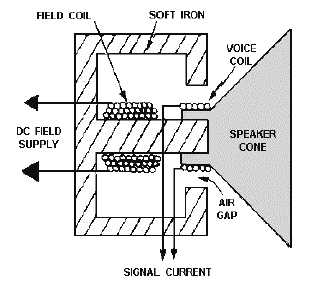2-31
Most speakers of the above type receive their input by means of transformer coupling. This is
necessary because of the normal, low impedance of the voice coil. You will find the standard impedance
values for this type speaker are 4, 8, 16, and 32 ohms. Other impedance values may be obtained, but those
listed are the most common.
While permanent magnet speakers perform reasonably well in the audio range, they have limitations.
Most Navy speakers reproduce low audio frequencies quite well, mid-band frequencies fairly well, and
high frequencies quite poorly. Let’s see why. When the speaker is constructed, only a limited number of
turns may be built into the voice coil. This gives us a fixed inductance. At low frequencies, the inductive
reactance of the voice coil is relatively low, and large audio currents flow. This provides a strong
magnetic field around the voice coil and a strong interaction with the field of the permanent magnet. Low
frequency response is excellent. At midband frequencies, inductive reactance increases and less current
flows in the voice coil. This produces less magnetic field and less interaction. Midband response is still
acceptable in a properly designed speaker. At high audio frequencies inductive reactance is quite high,
and little current flows in the voice coil. This results in a greatly reduced voice coil field and little
interaction with the permanent magnetic field. Also at high frequencies the interwinding capacitance of
the voice coil tends to shunt some of the high audio frequencies, which further reduces the high frequency
response.
Frequency response of most permanent magnet speakers falls off at the higher audio frequencies.
This problem is normally overcome either by the use of an expensive, specially designed speaker, or
through the use of two speakers, one of which is designed to operate well at the higher audio frequencies
(tweeter) and one at the lower frequencies (woofer).
As shown in figure 2-31, an electromagnet may be used in place of a permanent magnet to form an
electromagnetic dynamic speaker. When we do this, sufficient dc power must be available to energize the
field electromagnet. The operation otherwise is much the same as that of the permanent magnet type. This
type of speaker is seldom used in Navy equipment.
Figure 2-31.—Electromagnetic speaker.

